Evaluating the Impact of the COVID-19 Pandemic on Accessing HIV Services in South Africa: A Systematic Review
Abstract
:1. Introduction
1.1. Background
1.2. Rationale
1.3. Objectives
2. Materials and Methods
2.1. Eligibility Criteria
2.2. Search Strategy
- Health service* OR primary health care access* OR refer*;
- SARS-CoV-2 OR COVID-19;
- HIV infection* OR HIV test*;
- South Africa OR southern Africa.
2.3. Study Selection
2.4. Quality Appraisal
2.5. Risk of Bias
3. Results
3.1. Search Results
3.2. Study Characteristics
3.3. Risk of Bias
3.4. Result of Individual Studies
3.4.1. Consequences of the COVID-19 Pandemic on HIV Services
3.4.2. Patient and Provider Experiences
3.4.3. Recommendations and Adaptations of HIV Services
3.4.4. Implementation of Recommendations
4. Discussion
4.1. Consequences of the COVID-19 Pandemic on HIV Services
4.2. Patient and Provider Experiences
4.3. Recommendations and Adaptations of HIV Services
4.4. Implementation of Recommendations
4.5. Strengths and Limitations
5. Conclusions
Author Contributions
Funding
Institutional Review Board Statement
Informed Consent Statement
Data Availability Statement
Conflicts of Interest
Abbreviations
| ART | Antiretroviral Therapy |
| AIDS | Acquired Immune Deficiency Syndrome |
| CASP | Critical Appraisal Skills Programme |
| CCMDD | Central Chronic Medicine Dispensing and Distribution |
| CHW | Community Healthcare Worker |
| COVID-19 | Coronavirus disease 2019 |
| DHIS | Department of Health Information System |
| GBV | Gender-based Violence |
| HCW | Healthcare Worker |
| HIV | Human Immunodeficiency Virus |
| IPC | Infection Prevention and Control |
| PCR | Polymerase Chain Reaction |
| PHC | Primary Health Care |
| PiCo | Population, Interest, Context |
| PLWH | People Living With HIV |
| PMTCT | Prevention of Mother-to-Child Transmission |
| PPE | Personal Protective Equipment |
| PrEP | Pre-exposure Prophylaxis |
| UNAIDS | United Nations Programme on HIV/AIDS |
| WHO | World Health Organisation |
Appendix A
| PubMed | Web of Science | Ovid (MEDLINE) | |
|---|---|---|---|
| Search terms | (“Health Services”[Mesh] OR “primary health care”[Mesh] OR “health care”[tiab] OR “health service*”[tiab] OR refer*[tiab] or access*[tiab]) | TS = (“Health service*” OR “primary health care” OR “primary AND healthcare” OR “primary AND care” OR refer* OR access*) | (Health services OR primary health care OR primary healthcare OR health service* OR access* OR refer*).ti,ab. |
| AND | AND | AND | |
| (“SARS-CoV-2”[Mesh] OR “COVID-19”[Mesh] OR covid[tiab] OR coronavirus[tiab] OR “corona virus”[tiab]) | TS = (SARS-CoV-2 OR COVID-19 OR covid OR coronavirus OR “corona AND virus”) | (COVID-19 OR SARS-CoV-2 OR coronavirus).ti,ab. | |
| AND | AND | AND | |
| (“HIV Infections”[Mesh] OR HIV[tiab] OR “HIV test*”[tiab] OR “HIV diagnos*”[tiab]) | TS = (“human immunodeficiency virus” OR HIV OR “HIV infection*” OR “HIV test*” OR “HIV diagnos*”) | (HIV OR HIV infection* OR HIV test* OR HIV diagnos*).ti,ab. | |
| AND | AND | AND | |
| (“South Africa”[tiab] OR “southern Africa”[tiab]) | CU = (“South Africa” OR “southern Africa”) | (South Africa OR southern Africa).ti,ab. | |
| Filters applied | From 2018–2022 | From 2018–2022 | From 2018–2022 |
| English | English | English |
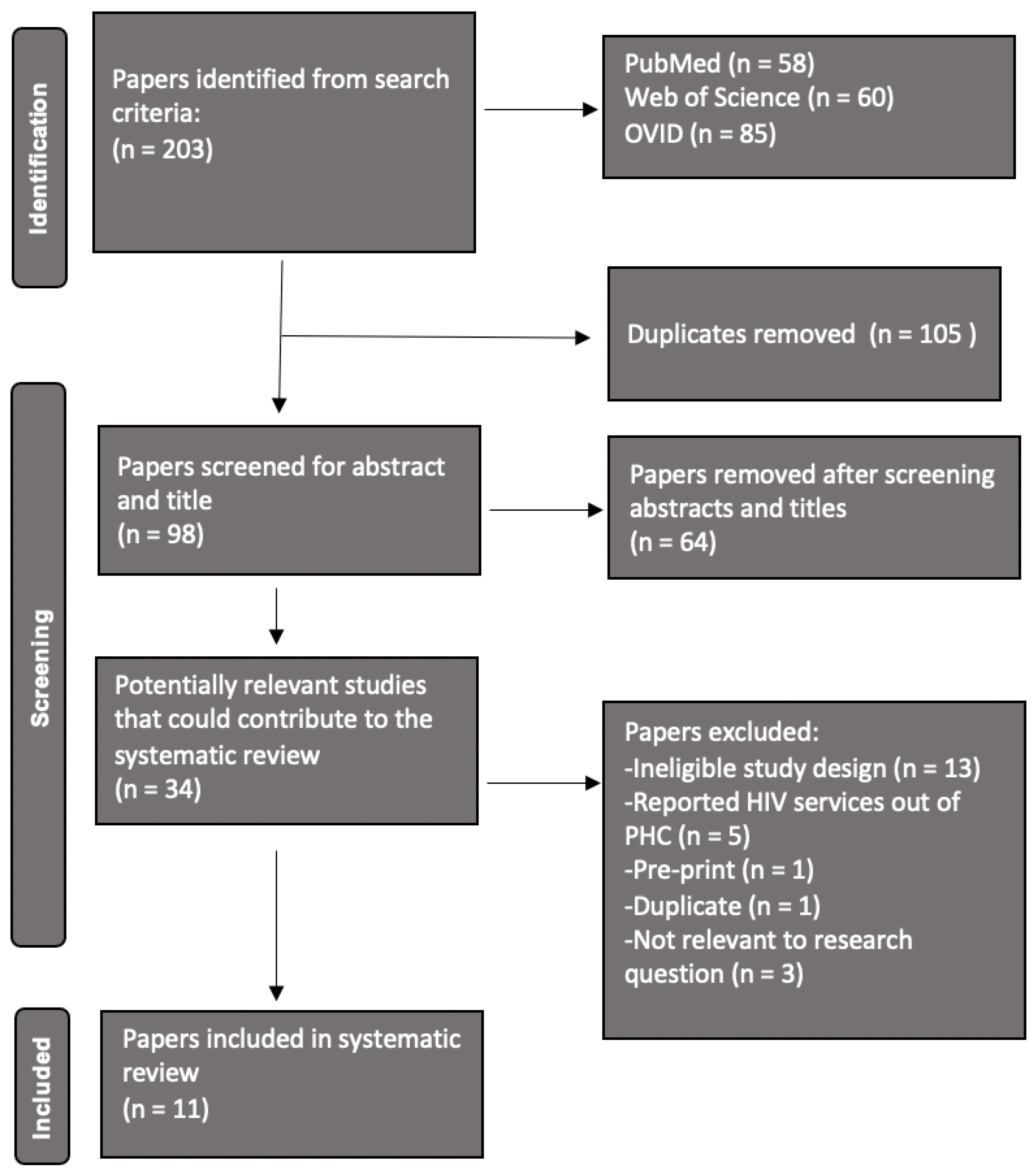
References
- World Health Organisation. HIV/AIDS. Available online: https://www.who.int/data/gho/data/themes/hiv-aids (accessed on 3 November 2021).
- Bain, L.E.; Nkoke, C.; Noubiap, J.J.N. UNAIDS 90–90–90 targets to end the AIDS epidemic by 2020 are not realistic: Comment on Can the UNAIDS 90–90–90 target be achieved? A systematic analysis of national HIV treatment cascades. BMJ Glob. Health 2017, 2, e000227. [Google Scholar] [CrossRef] [PubMed]
- Kim, H.; Tanser, F.; Tomita, A.; Vandormael, A.; Cuadros, D.F. Beyond HIV prevalence: Identifying people living with HIV within underserved areas in South Africa. BMJ Glob. Health 2021, 6, e004089. [Google Scholar] [CrossRef] [PubMed]
- UNAIDS. Global HIV & AIDS Statistics: 2020 Fact Sheet. 2020. Available online: https://www.unaids.org/en/resources/fact-sheet (accessed on 3 November 2021).
- Hodes, R. HIV/AIDS in South Africa. In Oxford Research Encyclopedia of African History; Oxford University Press: Oxford, UK, 2018. [Google Scholar]
- Mabaso, M.; Makola, L.; Naidoo, I.; Mlangeni, L.L.; Jooste, S.; Simbayi, L. HIV prevalence in South Africa through gender and racial lenses: Results from the 2012 population-based national household survey. Int. J. Equity Health 2019, 18, 167. [Google Scholar] [CrossRef] [PubMed]
- Statistics South Africa. Five Facts about Poverty in South Africa. 2019. Available online: https://www.statssa.gov.za/?p=12075 (accessed on 27 November 2021).
- Harris, B.; Goudge, J.; Ataguba, J.E.; McIntyre, D.; Nxumalo, N.; Jikwana, S.; Chersich, M. Inequities in access to health care in South Africa. J. Public Health Policy 2011, 32, S102–S123. [Google Scholar] [CrossRef]
- Naidoo, S. The South African national health insurance: A revolution in health-care delivery. J. Public Health 2012, 34, 149–150. [Google Scholar] [CrossRef]
- UNICEF. Health Budget Brief South Africa 2020. 2020. Available online: https://www.unicef.org/southafrica/media/4616/file/ZAF-health-budget-brief-2020.pdf (accessed on 1 December 2021).
- Malakoane, B.; Heunis, J.C.; Chikobvu, P.; Kigozi, N.G.; Kruger, W.H. Public health system challenges in the Free State, South Africa: A situation appraisal to inform health system strengthening. BMC Health Serv. Res. 2020, 20, 58. [Google Scholar] [CrossRef]
- Achoki, T.; Sartorius, B.; Watkins, D.; Glenn, S.D.; Kengne, A.P.; Oni, T.; Wiysonge, C.S.; Walker, A.; Adetokunboh, O.O.; Babalola, T.K.; et al. Health trends, inequalities and opportunities in South Africa’s provinces, 1990–2019: Findings from the Global Burden of Disease 2019 Study. J. Epidemiol. Community Health 2022, 76, 471–481. [Google Scholar] [CrossRef]
- Dookie, S.; Singh, S. Primary health services at district level in South Africa: A critique of the primary health care approach. BMC Fam. Pract. 2012, 13, 67. [Google Scholar] [CrossRef]
- McKenzie, A.; Schneider, H.; Schaay, N.; Scott, V.; Sanders, D. Primary Health Care Systems (Primasys); World Health Organization: Geneva, Switzerland, 2017; pp. 1–28. [Google Scholar]
- South African Government. About Alert System. 2020. Available online: https://www.gov.za/covid-19/about/about-alert-system (accessed on 3 November 2021).
- Hogan, A.B.; Jewell, B.L.; Sherrard-Smith, E.; Vesga, J.F.; Watson, O.J.; Whittaker, C.; Hamlet, A.; Smith, J.A.; Winskill, P.; Verity, R.; et al. Potential impact of the COVID-19 pandemic on HIV, tuberculosis, and malaria in low-income and middle-income countries: A modelling study. Lancet Glob. Health 2020, 8, e1132–e1141. [Google Scholar] [CrossRef]
- National Department Of Health: Republic of South Africa. Provincial Health Links. Available online: https://www.health.gov.za/ (accessed on 2 December 2021).
- Pillay, Y.; Pienaar, S.; Barron, P.; Zondi, T. Impact of COVID-19 on routine primary healthcare services in South Africa. S. Afr. Med. J. 2021, 111, 714. [Google Scholar] [CrossRef]
- Page, M.J.; McKenzie, J.E.; Bossuyt, P.M.; Boutron, I.; Hoffmann, T.C.; Mulrow, C.D.; Shamseer, L.; Tetzlaff, J.M.; Akl, E.A.; Brennan, S.E.; et al. The PRISMA 2020 statement: An updated guideline for reporting systematic reviews. BMJ 2021, 372, n71. [Google Scholar] [CrossRef]
- Mash, R.J.; Presence-Vollenhoven, M.; Adeniji, A.; Christoffels, R.; Doubell, K.; Eksteen, L.; Hendrikse, A.; Hutton, L.; Jenkins, L.; Kapp, P.; et al. Evaluation of patient characteristics, management and outcomes for COVID-19 at district hospitals in the Western Cape, South Africa: Descriptive observational study. BMJ Open 2021, 11, e047016. [Google Scholar] [CrossRef]
- Davey, D.L.J.; Bekker, L.-G.; Mashele, N.; Gorbach, P.; Coates, T.J.; Myer, L. PrEP retention and prescriptions for pregnant women during COVID-19 lockdown in South Africa. Lancet HIV 2020, 7, e735. [Google Scholar] [CrossRef]
- Jarolimova, J.; Yan, J.; Govere, S.; Bunda, B.A.; Ngobese, N.; Shazi, Z.M.; Khumalo, A.R.; Nelson, G.; Ngcobo, L.M.; Wara, N.J.; et al. Decentralised HIV care during the COVID-19 pandemic: Ensuring safe community-based services. S. Afr. Med. J. 2021, 111, 698. [Google Scholar] [CrossRef]
- Critical Appraisal Skills Programme. CASP Checklist. 2019. Available online: https://casp-uk.net/casp-tools-checklists/ (accessed on 10 October 2021).
- Campbell, L.S.; Masquillier, C.; Knight, L.; Delport, A.; Sematlane, N.; Dube, L.T.; Wouters, E. Stay-at-Home: The Impact of the COVID-19 Lockdown on Household Functioning and ART Adherence for People Living with HIV in Three Sub-districts of Cape Town, South Africa. AIDS Behav. 2022, 26, 1905–1922. [Google Scholar] [CrossRef]
- Siedner, M.J.; Kraemer, J.D.; Meyer, M.J.; Harling, G.; Mngomezulu, T.; Gabela, P.; Dlamini, S.; Gareta, D.; Majozi, N.; Ngwenya, N.; et al. Access to primary healthcare during lockdown measures for COVID-19 in rural South Africa: An interrupted time series analysis. BMJ Open 2020, 10, e043763. [Google Scholar] [CrossRef]
- Mutyambizi, C.; Dunlop, J.; Maluleke, C.; Ranoto, L.; Chetty, T.; Ndou, R.; Struthers, H.; A McIntyre, J.; Rees, K. Effect of COVID-19 on HIV, tuberculosis, and prevention of mother-to-child transmission of HIV indicators in Mopani district, South Africa. S. Afr. Med. J. 2021, 111, 1181. [Google Scholar] [CrossRef]
- Jensen, C.; McKerrow, N.H. Child health services during a COVID-19 outbreak in KwaZulu-Natal Province, South Africa. S. Afr. Med. J. 2020, 111, 114–119. [Google Scholar] [CrossRef]
- Perofsky, A.C.; Tempia, S.; Bingham, J.; Maslo, C.; Toubkin, M.; Laubscher, A.; Walaza, S.; Pulliam, J.R.C.; Viboud, C.; Cohen, C. Direct and Indirect Effects of the Coronavirus Disease 2019 Pandemic on Private Healthcare Utilization in South Africa, March 2020–September 2021. Clin. Infect. Dis. 2022, 27, e1000–e1010. [Google Scholar] [CrossRef]
- Dorward, J.; Khubone, T.; Gate, K.; Ngobese, H.; Sookrajh, Y.; Mkhize, S.; Jeewa, A.; Bottomley, C.; Lewis, L.; Baisley, K.; et al. The impact of the COVID-19 lockdown on HIV care in 65 South African primary care clinics: An interrupted time series analysis. Lancet HIV 2021, 8, e158–e165. [Google Scholar] [CrossRef]
- Rees, K.; Dunlop, J.L.; Patel-Abrahams, S.; Struthers, H.; McIntyre, J.A. Primary healthcare workers at risk during COVID-19: An analysis of infections in HIV service providers in five districts of South Africa. S. Afr. Med. J. 2021, 111, 309–314. [Google Scholar] [CrossRef]
- World Health Organisation. Pulse survey on Continuity of Essential Health Services during the COVID-19 Pandemic. 2020. Available online: https://www.who.int/publications/i/item/WHO-2019-nCoV-EHS_continuity-survey-2020.1 (accessed on 15 December 2021).
- Ginsburg, C.; Collinson, M.A.; Gómez-Olivé, F.X.; Gross, M.; Harawa, S.; Lurie, M.N.; Mukondwa, K.; Pheiffer, C.F.; Tollman, S.; Wang, R.; et al. Internal migration and health in South Africa: Determinants of healthcare utilisation in a young adult cohort. BMC Public Health 2021, 21, 554. [Google Scholar] [CrossRef]
- The Global Fund. The Impact of COVID-19 on HIV, TB and Malaria Services and Systems for Health. 2020. Available online: https://www.theglobalfund.org/media/10776/covid-19_2020-disruption-impact_report_en.pdf. (accessed on 1 July 2022).
- Chitungo, I.; Mhango, M.; Mbunge, E.; Dzobo, M.; Musuka, G.; Dzinamarira, T. Utility of telemedicine in sub-Saharan Africa during the COVID-19 pandemic. A rapid review. Hum. Behav. Emerg. Technol. 2021, 3, 843–853. [Google Scholar] [CrossRef]
- Boyd, A.T.; Jahun, I.; Dirlikov, E.; Greby, S.; Odafe, S.; Abdulkadir, A.; Odeyemi, O.; Dalhatu, I.; Ogbanufe, O.; Abutu, A. Expanding access to HIV services during the COVID-19 pandemic—Nigeria, 2020. AIDS Res. Ther. 2021, 18, 62. [Google Scholar] [CrossRef]
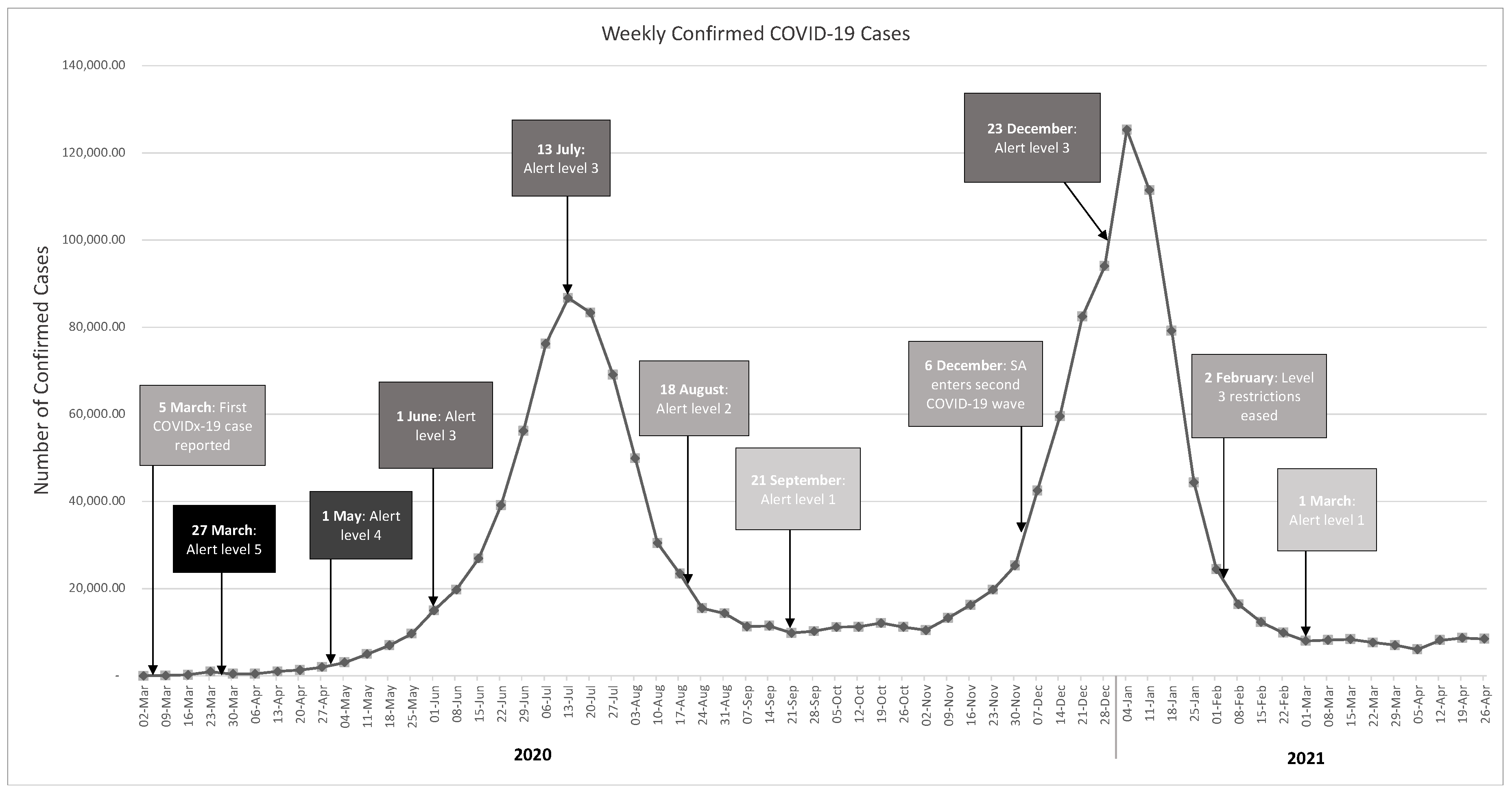
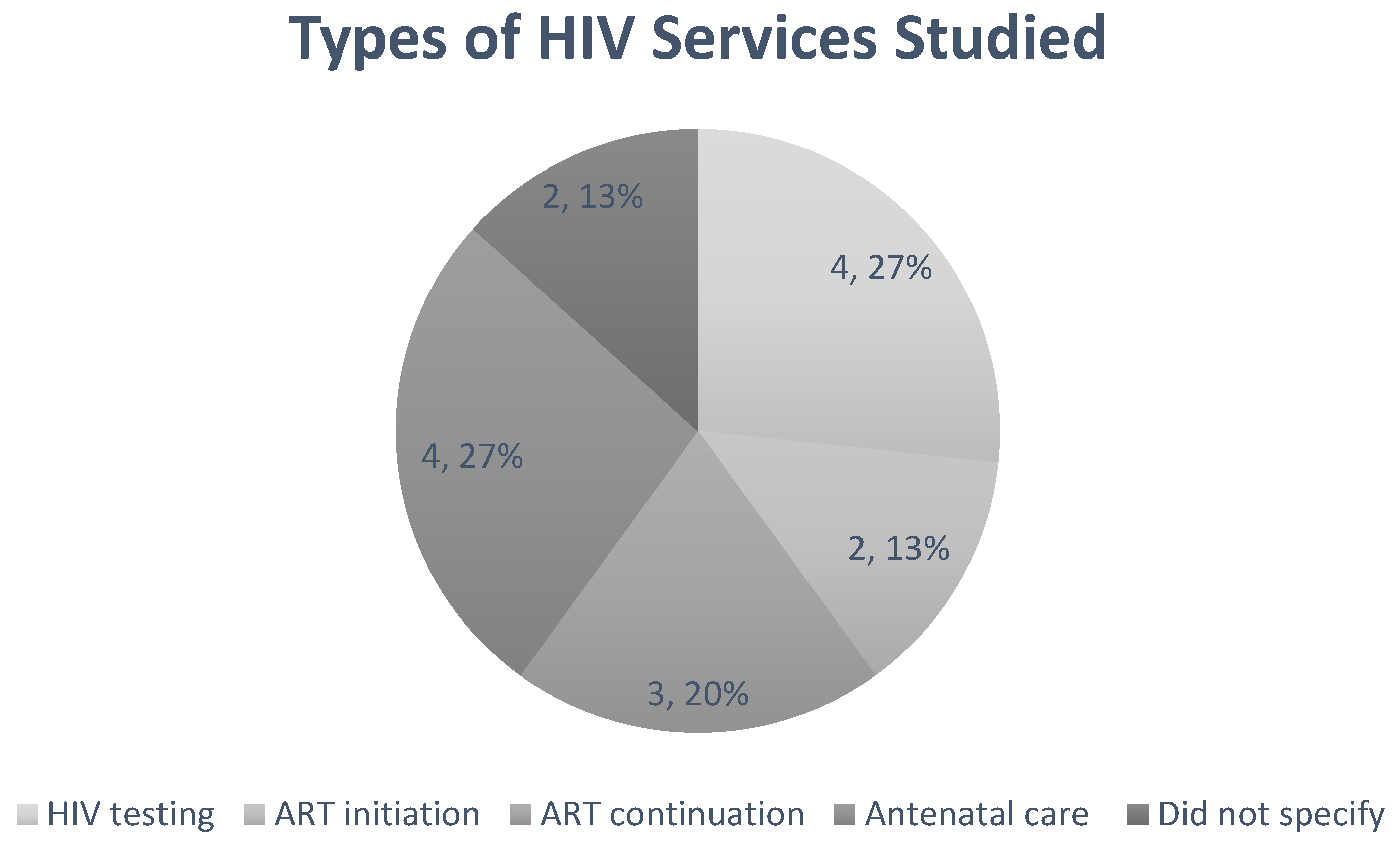
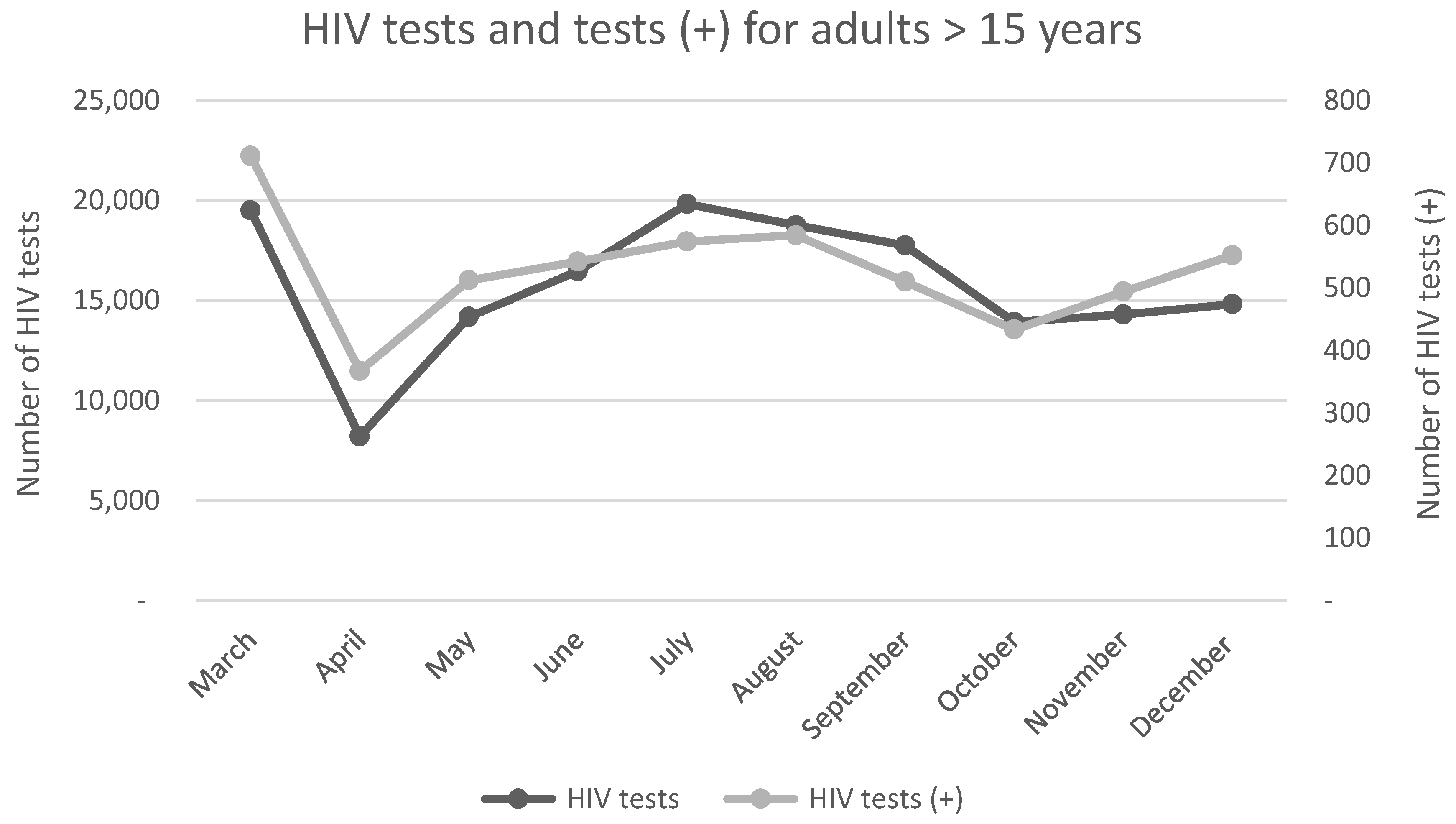
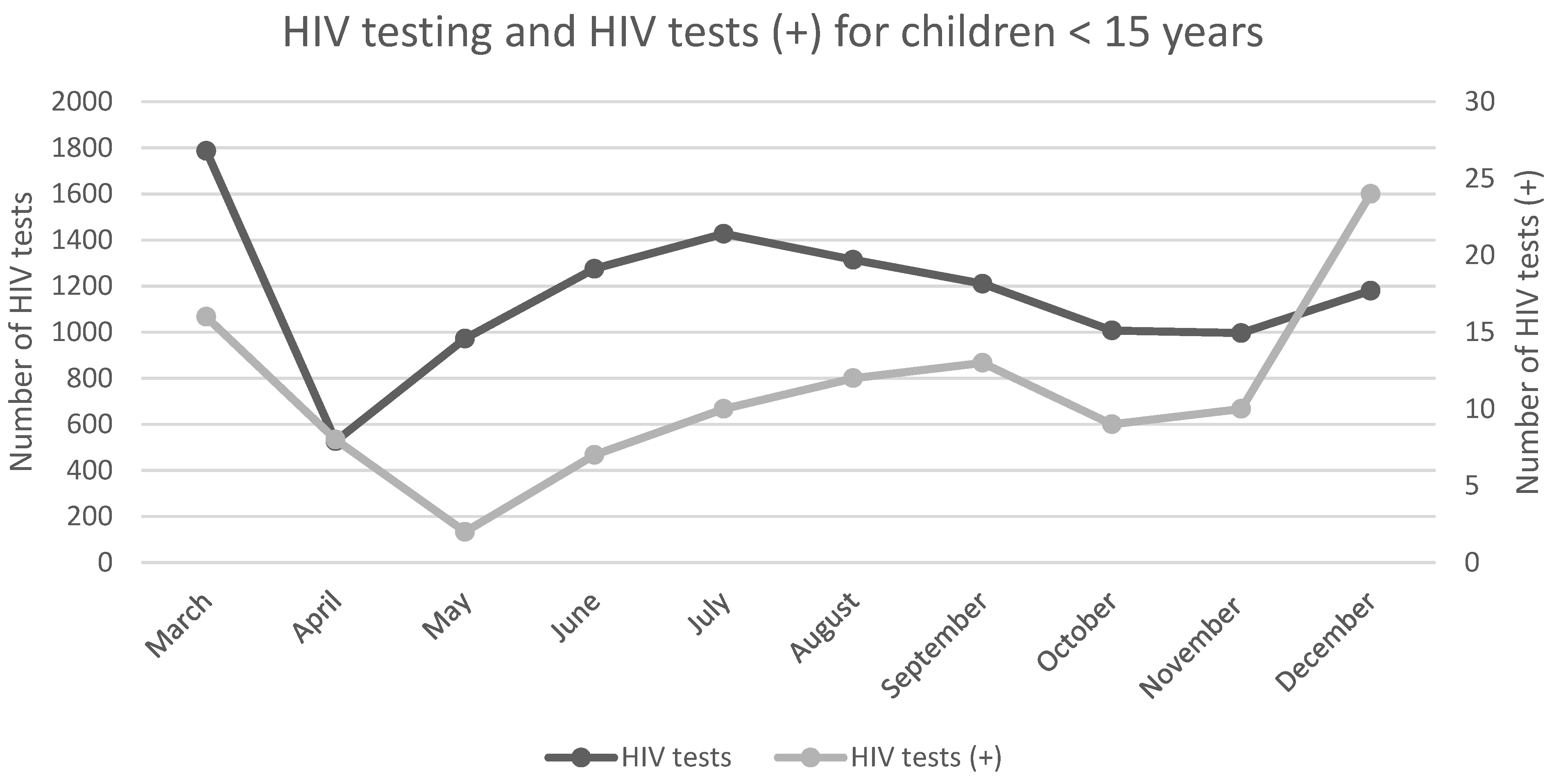
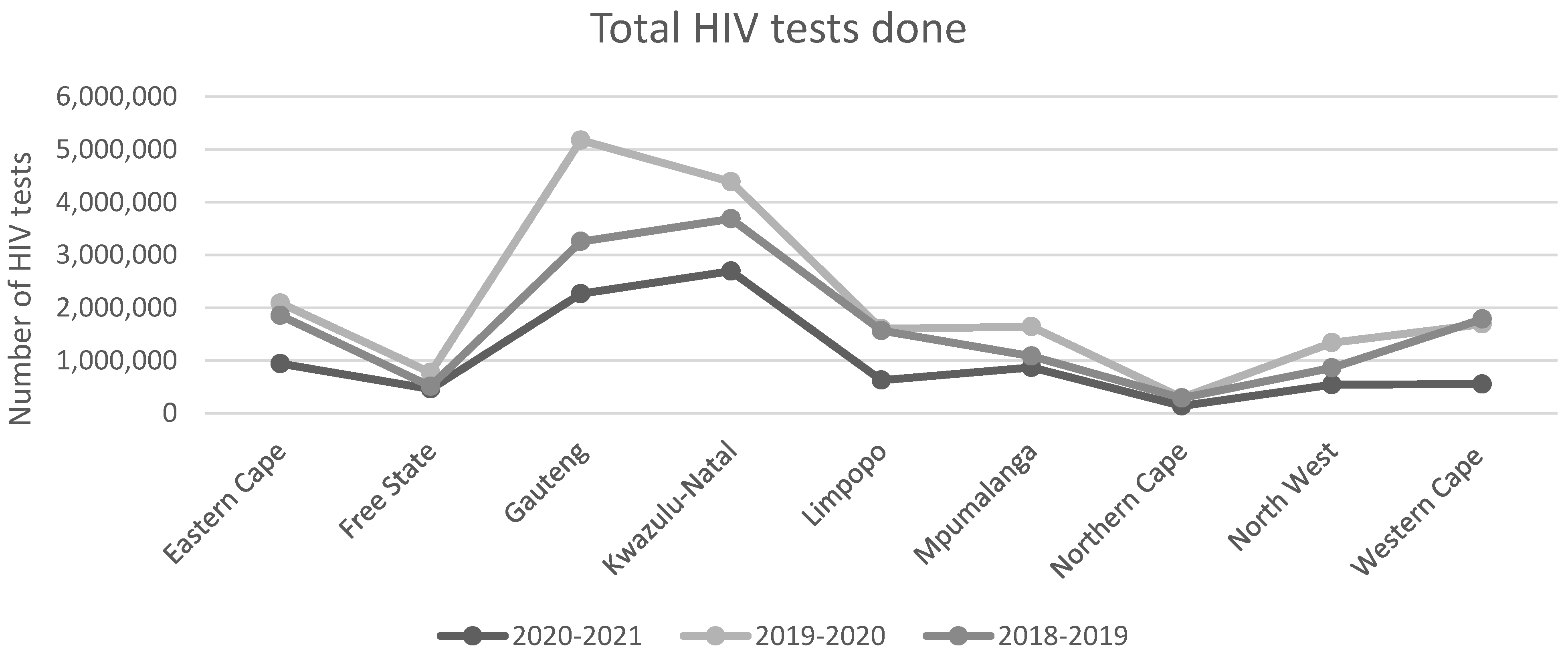
| Inclusion Criteria | Exclusion Criteria | |
|---|---|---|
| Population |
|
|
| Interest |
|
|
| Context |
|
|
| Study design |
|
|
| Author and Date | Aim of Study | Location | Journal Rank | Data Source | Type of HIV Service(s) Reported | Study Conclusion |
|---|---|---|---|---|---|---|
| [22] | To investigate changes in individual, social, and structural factors during the COVID-19 pandemic, and whether these changes impacted ART adherence during the lockdown. | Cape Metro area, Western Cape | Q1 | Base-line and follow-up data from participants in the Sinako trial (31) |
|
|
| [19] | To evaluate the effect of the COVID-19 pandemic on PrEP-PP study visits and on PrEP prescription refill visits among pregnant women in antenatal care | Cape Town, Western Cape | Q1 | Cohort study |
|
|
| [23] | To measure the impact of the COVID-19 lockdown on HIV testing and treatment | Kwazulu-Natal | Q1 | District Health Information System (DHIS) |
|
|
| [24] | To assess the impact of the COVID-19 outbreak on routine child health services | Kwazulu-Natal | Q3 | District Health Information System (DHIS) |
|
|
| [18] | To evaluate the characteristics, clinical management and outcomes of patients with COVID-19 at district hospitals | Western Cape | Q1 | Medical records from eight district hospitals | - |
|
| [25] | To analyse trends in HIV, TB and PMTCT indicators during the COVID-19 lockdown | Mopani district, Limpopo | Q3 | District Health Information System (DHIS) |
|
|
| [26] | To assess the direct and indirect effects of the COVID-19 pandemic on private healthcare utilisation | All nine provinces | Q1 | Data provided by Netcare and Medicross |
|
|
| [27] | To assess the impact of COVID-19 on routine primary healthcare services | All nine provinces | Q3 | District Health Information System (DHIS) |
|
|
| [28] | To analyse the rates of COVID-19 infection amongst Anova-employed HCWs | Cape Town, Western Cape Johannesburg, Gauteng Capricorn and Mopani, Limpopo Sedibeng, Gauteng | Q3 | Employee database |
|
|
| [29] | To evaluate whether the implementation of lockdown affected access to PHC | Northern Kwazulu-Natal | Q1 | Agincourt health and socio-demographic surveillance system (HDSS) |
|
|
| [20] | To evaluate the effectiveness of decentralised HIV care during the COVID-19 pandemic | Kwazulu-Natal | Q3 | Interviews with 112 clinic staff and 24 pick-up point staff |
|
|
| Reference | 1–26 March 2020 | 26 March–30 April 2020 | 1–31 May 2020 | 1 June–17 August 2020 | 18 August–21 September 2020 | 21 September–28 December 2020 |
|---|---|---|---|---|---|---|
| Pre-Lockdown | Level 5 | Level 4 | Level 3 | Level 2 | Level 1 | |
| [22] | HIV tests positive per month are 6.1% (IQR 5.4–7.0%) | 47.6% decrease in HIV testing (IRR 0.524, 95% CI 0.446–0.615) | HIV testing reaches 82.7% of pre-lockdown levels (IRR 0.827, 95% CI 0.704–0.972) | |||
| HIV tests positive per month are 4.3% (IQR 4.0–4.8%) | ||||||
| [23] | Infant PCR testing at birth declined by 5% in March, and 6% in April (p = 0.01) | Infant PCR testing at birth declined by 15% (p = 0.01) | Infant PCR testing at birth declined by 15% (p = 0.01) | |||
| [27] | Significant decrease in HIV testing for the age group 18 months–14 years (n = 665; p = 0.05) | Statistically significant increase in the monthly trend for HIV testing (p = 0.031) and HIV tests (+) (p = 0.003) for age groups 18 months–14 years | Significant decrease in HIV testing for the age group 18 months–14 years (n = 697; p = 0.01) | |||
| Significant decrease in HIV testing for age group 15 years (n = 10,592; p = 0.01) | Highly significant increase in HIV testing and positive HIV tests for age group 15 years (p < 0.001) | Significant decrease in HIV testing for age group 15 years (n = 7056; p = 0.01) | ||||
| PCR testing and PCR test (+) are unaffected | ||||||
| Significant decrease in HIV test (+) for the age group 18 months–14 years (n = 22; p = 0.01) | Statistically significant decreases in PCR testing (p = 0.022) and no significant change to PCR tests (+) (p = 0.258) | Significant decrease in HIV test (+) for the age group 15 years (n = 195; p = 0.01) | ||||
| Significant decrease in HIV test (+) for the age group 15 years (n = 277; p = 0.01) | ||||||
| [29] | Largest national decline in HIV testing | |||||
| Reference | 1–26 March 2020 | 26 March–30 April 2020 | 1–31 May 2020 | 1 June–17 August 2020 | 18 August–21 September 2020 | 21 September–28 December 2020 |
|---|---|---|---|---|---|---|
| Pre-Lockdown Period | Level 5 | Level 4 | Level 3 | Level 2 | Level 1 | |
| [22] | Increase in number of ART collection visits (IRR 1.233, 95% CI 1.113–1.366) | 46.2% decrease in ART initiations (IRR 0.538, 95% CI 0.459–0.630) | ART initiations reach 75.3% of pre-lockdown levels (IRR 0.753, 95% CI 0.637–0.890) | |||
| Weak evidence of a small decrease in number of ART collection visits (IRR 0.932, 95% CI 0.794–1.093) | Some evidence suggests ART collection visits were lower than pre-lockdown levels (IRR 0.859, 95% CI 0.747–0.989) | |||||
| [27] | 45% decrease in ART initiation for the age group < 15 years | Statistically significant decreases in adults and children initiating ART | No recovery in ART initiation rate | |||
| 33% decrease in ART initiation for treatment-naïve adults | ||||||
| 41% decrease in ART initiation for treatment-naïve children naïve | ||||||
| 1% decrease in ART continuation for children < 15 years | ||||||
| [24] | 37.6 mean daily HIV-related clinical visits | 45.5 mean daily HIV-related clinical visits, an estimated 20% increase | 56.6 mean daily HIV-related clinical visits | 60.6 mean daily HIV-related clinical visits | ||
| Social, Structural or Individual Factor | Impact of COVID-19 on Social, Structural or Individual Factors | Impact on ART Adherence |
|---|---|---|
| Healthcare access | A minority (15.66%) of participants reported issues with accessing health care to support their ART adherence. | There was limited evidence of an association between healthcare access and ART adherence (−1.30, t = −2.69, p = 0.009). |
| Food insecurity | The majority of participants (60%) reported issues obtaining food during lockdown. | Participants who stated that in their household, adult food consumption was often restricted reported lower ART adherence scores (−1.19, Z = −2.33, p = 0.02). |
| Economic insecurity | 78.95% of participants reported falling below the poverty line. | There was no evidence of an association between ART adherence scores and household income (0.13, t = 0.29, p = 0.78). |
| Household HIV stigma | A decrease in household HIV stigma was reported, with 50% of participants reporting that they do not feel blamed by their household members because of their HIV status. | Experiencing stigma was negatively associated with ART adherence scores (−4.06, t = −2.86, p = 0.002). |
| Household violence | A decrease in household violence was reported, with 92.77% of participants reporting no instances of household violence following lockdown. | There was strong evidence that experiencing all forms of violence was associated with lower ART adherence scores (−2.09, t = −2.55, p = 0.01). |
| Household functioning | Following lockdown, more participants (95.18%) reported a feeling of togetherness in their household. | Participants whose household members did not work together to work out problems reported lower ART adherence scores (−3.02, t = −3.01, p = 0.004). |
| Self-reported wellbeing | Over a quarter of participants reported feeling more depressed since the arrival of COVID-19 (29%), and since the start of lockdown (27%). | Participants feeling depressed during the lockdown reported lower ART adherence scores (−1.17, t = −2.47, p = 0.02). |
Publisher’s Note: MDPI stays neutral with regard to jurisdictional claims in published maps and institutional affiliations. |
© 2022 by the authors. Licensee MDPI, Basel, Switzerland. This article is an open access article distributed under the terms and conditions of the Creative Commons Attribution (CC BY) license (https://creativecommons.org/licenses/by/4.0/).
Share and Cite
Jardim, C.G.R.; Zamani, R.; Akrami, M. Evaluating the Impact of the COVID-19 Pandemic on Accessing HIV Services in South Africa: A Systematic Review. Int. J. Environ. Res. Public Health 2022, 19, 11899. https://doi.org/10.3390/ijerph191911899
Jardim CGR, Zamani R, Akrami M. Evaluating the Impact of the COVID-19 Pandemic on Accessing HIV Services in South Africa: A Systematic Review. International Journal of Environmental Research and Public Health. 2022; 19(19):11899. https://doi.org/10.3390/ijerph191911899
Chicago/Turabian StyleJardim, Claudia Goncalves Rebelo, Reza Zamani, and Mohammad Akrami. 2022. "Evaluating the Impact of the COVID-19 Pandemic on Accessing HIV Services in South Africa: A Systematic Review" International Journal of Environmental Research and Public Health 19, no. 19: 11899. https://doi.org/10.3390/ijerph191911899
APA StyleJardim, C. G. R., Zamani, R., & Akrami, M. (2022). Evaluating the Impact of the COVID-19 Pandemic on Accessing HIV Services in South Africa: A Systematic Review. International Journal of Environmental Research and Public Health, 19(19), 11899. https://doi.org/10.3390/ijerph191911899






